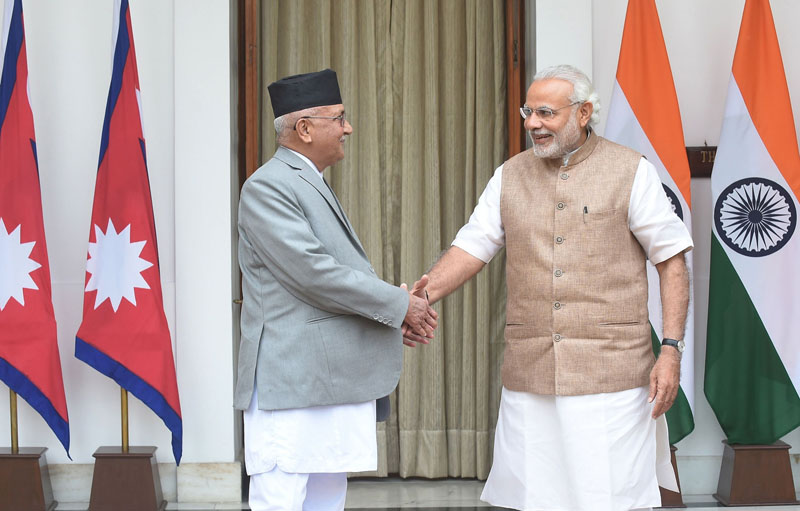Nepal, India seal nine agreements in New Delhi
Deals related to earlier pledges such as energy, trade, transit facilities and culture
Kathmandu, February 20
Nepal and India today sealed a seven-point deal during a meeting between Prime Minister KP Sharma Oli and his Indian counterpart Narendra Modi at Hyderabad House in New Delhi.
These nine agreements and Letters of Exchange that are incorporated in a seven point deal are on a wide range of bilateral issues, including energy trade, transit facilities, cultural exchanges as well as road construction and post-earthquake reconstruction support.
Most of the agreements that have been signed are not new though. They are related to continuation and execution of previous pledges between the two sides.
The two prime ministers inaugurated the 400 KV Muzaffarpur-Dhalkebar transmission line for supply of Indian electricity to Nepal under an Indian credit line of US$ 13.5 million.
As per the understanding, Nepal will get 80MW power immediately, which will be augmented to 200 MW by October this year and then to 600 MW by December 2017.
A Memorandum of Understanding was signed on utilisation of a US$ 250 million grant component of India, which was pledged during a donors’ conference in Kathmandu in June last year for the post-quake reconstruction.
The amount will be funded for four identified sectors: housing, health, education and cultural heritage.
According to the statement issued to mediapersons, US$ 100 million will be utilised for construction of 50,000 houses in 14 districts that were severely affected by the April 25 earthquake. Around $50 million will be used for each of these sectors: health, education and cultural heritage in 31 earthquake-affected districts of Nepal.
Another MoU related to strengthening the road infrastructure in the Tarai, which will enable speedy completion of the remaining part of the postal highway, whose construction had been stopped for years, was signed.
Yet another MoU was sealed between Nepal Academy of Music and Drama, and Sangeet Natak Academy of India to enhance cooperation in the field of arts through exchanges of experts, exponents, dancers, scholars and intellectuals.
Similarly, two LoEs on transit routes were exchanged to simplify traffic of goods between Nepal and Bangladesh while transiting via India; and utilisation of Vishakhapatnam Port of India.
Besides, two other LoEs, allowing rail transport to and from Vishakhapatnam to Nepal and to operationalise rail transit facility through Singabad of India for Nepal-Bangladesh trade were exchanged.
Finally, the two countries jointly announced four names from their respective sides for an eight-member Eminent Persons Group, which was agreed upon during the 3rd Joint Commission meeting in July 2014.
Although the Nepali side had already given four names for the EPG, the Indian side had not announced names for the joint mechanism, which has been mandated to review bilateral relations and recommend measures, including institutional frameworks to further enhance bilateral relations.
Nepal’s representation in the EPG include lawmaker Rajan Bhattarai, former foreign minister Bhek Bahadur Thapa, former chief commissioner of the Commission for the Investigation of Abuse of Authority Surya Nath Upadhyay and former law minister Nilambar Acharya.
The Indian EPG members are lawmaker and senior Bharatiya Janata Party leader Bhagat Singh Koshyari, former Sikkim University vice-chancellor Mahendra Lama, former Indian ambassador to Nepal Jayant Prasad and VIF senior fellow BC Upreti.






